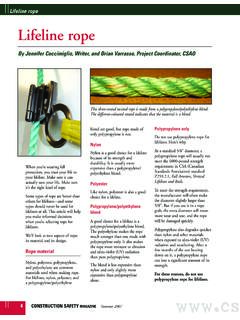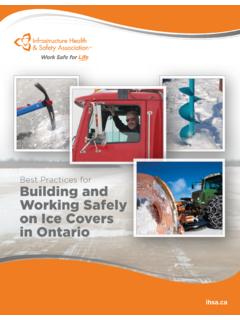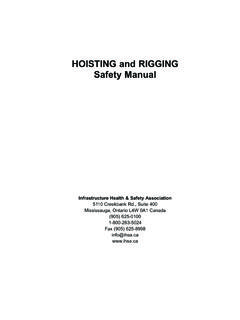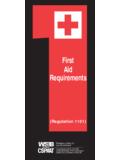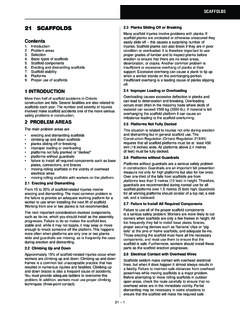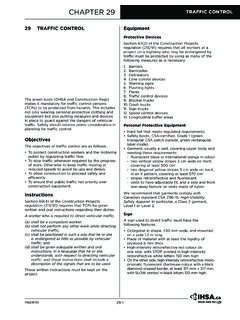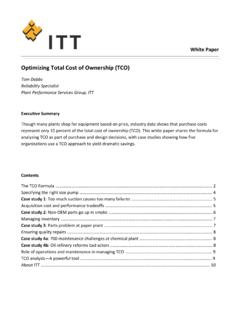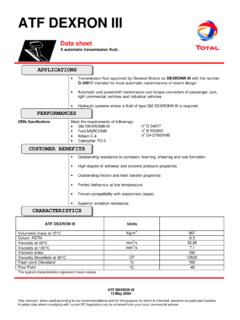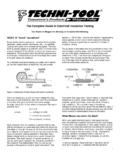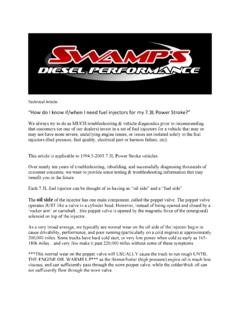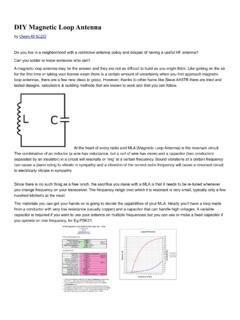Transcription of Construction Health and Safety Manual - Ch.31 …
1 31 1 TRENCHING31 TRENCHINGC ontents Background Soil types Causes of cave-ins Protection against cave-ins Other hazards and safeguards Emergency proceduresBackgroundFatalitiesA significant number of deaths and injuries insewer and watermain work are directly relatedto fatalities are mainly caused by cave-ins. Death occurs by suffocation orcrushing when a worker is buried by falling soil. Over half of all powerline contacts involve buriedcable. Before excavating, the gas, electrical, andother services in the area must be accuratelylocated and marked. If the service poses ahazard, it must be shut off and disconnected.
2 InjuriesThe following are the main causes of lost-timeinjuries in the sewer and watermain industry: materials and equipment falling into thetrench slips and falls as workers climb on and offequipment unloading pipe handling and placing frames and coversfor manholes and catch basins handling and placing pipe and othermaterials being struck by moving equipment falls as workers climb in or out of anexcavation falling over equipment or excavatedmaterial falling into the trench exposure to toxic, irritating, or of these injuries are directly related and workers in the sewer andwatermain industry must be familiar with the Excavations section of the ConstructionRegulation, It is important to understand, for instance, theterms trench and excavation.
3 An excavationis a hole left in the ground as the result ofremoving material. A trench is an excavation inwhich the depth exceeds the width (Figure 1).The Excavations section of the ConstructionRegulation identifies the various types of soilsand specifies the type of shoring and timberingto be used for each. It also spells out therequirements for trench support systems thatmust be designed by a professional between excavation and trenchFigure 1 Excavation10'5'10'5'Trench31 2 TRENCHINGSoil typesThe type of soil determines the strength andstability of trench soil types requires knowledge, skill,and experience.
4 Even hard soil may containfaults in seams or layers that make it unstablewhen foreman or supervisor must beknowledgeable about soil types found on aproject and plan protection accordingly. Thisknowledge must include an awareness that soiltypes and conditions can change over very shortdistances. It is not unusual for soil to changecompletely within 50 metres or for soil tobecome saturated with moisture over evensmaller Construction Regulation sets out four soiltypes. If you are unsure about the soil type,have the soil tested to confirm the 1 It is hard to drive a pick into Type 1soil.
5 Hence, it is often described as hardground to dig . In fact, the material is so hard, itis close to excavated, the sides of the excavationappear smooth and shiny. The sides will remainvertical with no water released from the exposed to sunlight for several days, the wallsof Type 1 soil will lose their shiny appearancebut remain intact without cracking exposed to rain or wet weather, Type 1 soilmay break down along the edges of Type 1 soils include hardpan, consolidated clay, and some glacial 2 A pick can be driven into Type 2soil relatively easily.
6 It can easily be excavatedby a backhoe or hand-excavated with Type 2 soil, the sides of a trench will remainvertical for a short period of time (perhapsseveral hours) with no apparent tension , if the walls are left exposed to air andsunlight, tension cracks will appear as the soilstarts to dry. The soil will begin cracking andsplaying into the Type 2 soils are silty clay and less 3 Much of the Type 3 soil encounteredin Construction is previously excavated 3 soil can be excavated without difficultyusing a hydraulic dry, Type 3 soil will flow through fingersand form a conical pile on the ground.
7 DryType 3 soil will not stand vertically and thesides of the excavation will cave in to a naturalslope of about 1 to 1 depending on Type 3 soil will yield water when vibratedby hand. When wet, this soil will stand verticallyfor a short period. It dries quickly, however,with the vibration during excavation causingchunks or solid slabs to slide into the backfilled or previously disturbed materialshould be treated as Type 3. Other typical Type3 soil includes sand, granular materials, and siltyor wet 4 Type 4 soil can be excavated withno difficulty using a hydraulic backhoe.
8 Thematerial will flow very easily and must besupported and contained to be excavated to anysignificant its high moisture content, Type 4 soil isvery sensitive to vibration and otherdisturbances which cause the material to Type 4 material includes muskeg orother organic deposits with high moisturecontent, quicksand, silty clays with highmoisture content, and leta clays. Leta clays arevery sensitive to disturbance of any 3 TRENCHINGC auses of Cave-InsSoil properties often vary widely from the top tothe bottom and along the length of a factors such as cracks, water, vibration,weather, and previous excavation can affecttrench stability (Figure 2).
9 Time is also a criticalfactor. Some trenches will remain open for along period, then suddenly collapse for noapparent 3 shows the typical causes of cave-ins. The main factors affecting trench stability aresoil type, moisture, vibration, surcharge,previous excavation, existing foundations, contentThe amount of moisture in the soil has a greateffect on soil a trench is dug, the sides of the openexcavation are exposed to the air. Moisturecontent of the soil begins to change almostimmediately and the strength of the walls maybe longer an excavation is open to the air, thegreater the risk of a open for extended duration may collapse without apparent vibrationaffects isless stable thanundisturbed such as spoil pile puts more pressure on trench 3 Large LoadRainInsufficient ShoringVibrationCracksBroken LineHigh Water TableWater SeepageSettlingFigure 2 - Many factors affect trench 4 TRENCHINGV ibrationVibration from various sources can affect trenchstability.
10 Often trench walls are subject to vibration fromvehicular traffic or from Construction operationssuch as earth moving, compaction, pile driving,and blasting. These can all contribute to thecollapse of trench surcharge is an excessive load or weight thatcan affect trench instance, excavated soil piled next to thetrench can exert pressure on the of spoil piles is therefore should be kept as far as is practical fromthe edge of the trench. Mobile equipment andother material stored close to the trench alsoadd a surcharge that will affect trench metre from the edge to the toe of the spoilpile is the minimum distance requirement(Figure 4).
